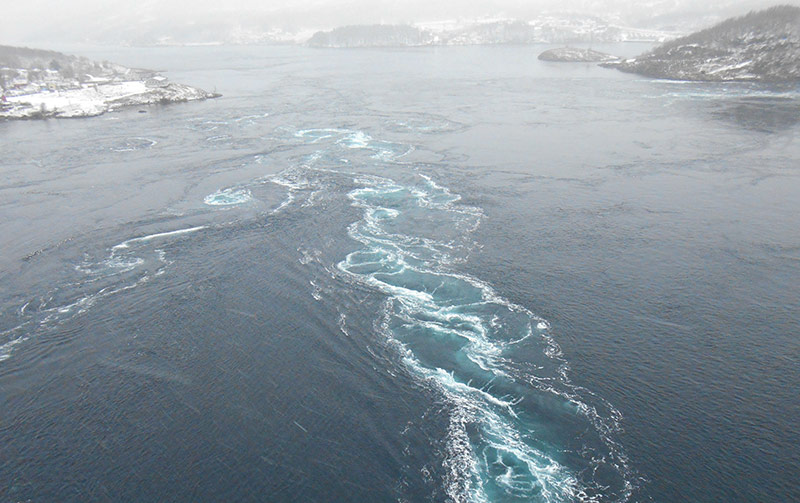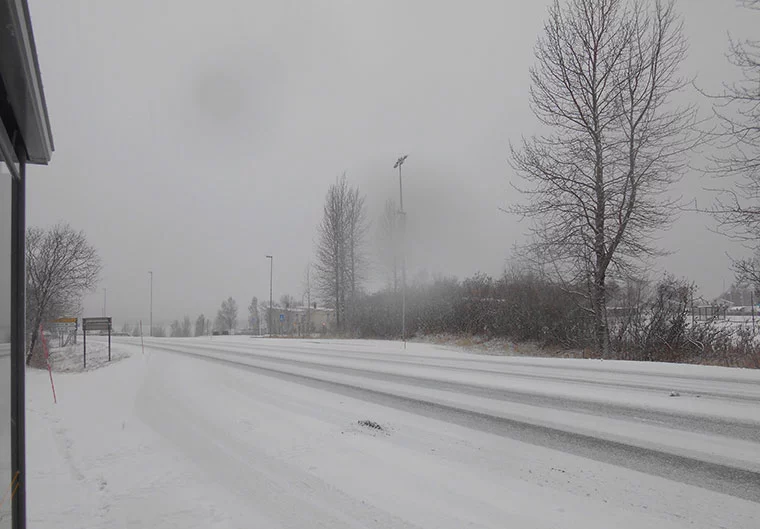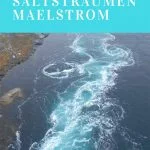One writer's visit from Bodø to snow-covered Saltstraumen on a cold November day.
If you’re in Bodø, you go to Saltstraumen. Or, if you don’t, you’ve got to have a super valid reason for not going – e.g. you’ve already been there at least once.

I’ve now been to Saltstraumen once (so far), but honestly, not even that counts as good enough a reason to not go back again.
Saltstraumen is a small strait around 10 km southeast of Bodø. The channel connects the Saltenfjord to the Skjerstadfjord, and is where the world’s strongest tidal current happens to be.
The direction of the current changes every six hours or so: that’s when the maelstrom is at its most powerful.
The times of the day when the current is at its strongest vary, so there’s a dedicated, super detailed daily timetable to refer to. This way, one can easily double-check in advance when it’s best to go on a specific day of the year.
Safaris and group trips with local guides are very popular among tourists. What’s more, Saltstraumen is super rich in marine fauna and seabirds, which explains why sports divers and birdwatchers also like it a lot. Last but not least, it is a haven for fishermen, who take advantage of the current in the hope of a big catch.
I didn’t want to visit Saltstraumen on a group tour, nor did I know whether there’d be any planned at all during the winter season. So, because I was on my own and with no car, I had to rely on public transport.

But, again, also due to the season, buses were not uber frequent, so I checked the bus times super carefully the day before. It was my one chance to go to Saltstraumen during my stay in Bodø, I didn’t want to blow it only because I failed to check buses in advance.
The tide would be at its strongest around 10.22 in the morning, so I had to go for the 7.41 bus. The next bus would be too late: I wanted to make sure I’d be around the strait in the daylight.
The thing that welcomed me in the morning was… SNOW, and a lot of it. It had snowed nonstop overnight, and Bodø was coated in white. (Spoiler alert: it wasn’t going to stop. At all.)
During the bus journey I couldn’t see a thing: the windows were all blurry and it was pitch black outside. I had no idea where I was, and I was counting the stops in my head to keep up with the bus route. I got off at Høgåsen, and the bus left.
I stood there alone in the silence for about half an hour. I could almost hear the noise of the snowflakes as they hit the ground. Daylight came, but it felt much darker than the day before.
I boarded the second bus, got off at my stop and, again, the bus left. At first I was completely alone in the snow by the road. Then I started growing familiar with the surroundings. There was a church (closed), the Saltstraumen museum (also seemingly closed), the deserted road and… the bridge! The bridge over the strait! I knew my way.

Okay, be prepared: once you find your way around the strait, it’ll be tough to make an orderly plan of what to see in which order, because you will want to go everywhere first. I believe the itinerary I picked kind of made sense, as it allowed me to see pretty much everything in the area.
When I got to the bridge I realised I still had some time before the maelstrom reached its peak, so I thought I’d explore the area underneath the bridge first. It’s easy if you take the path right to its left. As I headed downhill, I came across a café (closed) and a souvenir shop (also closed).
I walked past, straight toward the channel. There the path turned right and, suddenly, the landscape was like straight out of a winter fairy tale, with snow-covered red cabins and a narrower channel right next to the strait.
The footpath then goes up the hillside, where it offers stunning views of the strait, the bridge itself and the open sea.
As I walked back to the bridge, I noticed that the current had gained strength. I soon found myself standing by one of the bridge concrete pillars. There’s an iron railing, so you can (relatively) safely watch the current, and see for yourself how fast the water flows. It’s unbelievable!
There’s also a tiny lighthouse just there but, apart from that, it’s all rocky shore and the rumbling noise of water.

Despite the (truly) terrible weather, two fishermen were effortlessly standing on the rocks by one of whirlpools, patiently waiting for some big fish to make their day.
Only the birds were even cooler than the fishermen: they were perched in small groups right along the edge of the vortex, lulled by the waves, seemingly oblivious to the strength of the maelstrom. They were so funny.
The view from the bridge doesn’t get less amazing. In fact, it’s from there that you really appreciate the proportion of the phenomenon and the size of the whirlpools.
Because of the thick snowfall, I could barely see a thing. The horizon was all blurry, it was white all around, and the water was almost black, except by the whirlpools, where it gradually changed to light blue, almost aquamarine.
I also reached the opposite side of the bridge, and went down to the shore. You have to be extra careful if you go down that way, though. The wooden staircase had a couple of loose and missing steps, and the rocks were super slippery.

I walked back to the bus stop in the heavy snow and, as two women hurried to the same bus shelter where I was standing, I realised that (aside from the fishermen) those were the first people I’d seen since I’d got off the bus a couple of hours earlier.
I believe the weather, the season and the (consequent) absence of people contributed to making my Saltstraumen experience fairly unique overall, and that’s is something I’m very excited about.
Just because I’ve been there once, though, it’s not that I don’t want to go back again, if you know what I mean 🙂
If you’re heading to Saltstraumen, you might find the local bus company's website useful – 177 Nordland – and you can check with your hotel or the local tourist information office for the season's timetable.


